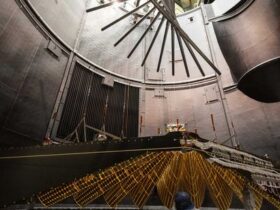Alcyoneus is a massive radio galaxy 3 billion light-years away that reaches 5 megaparsecs into space. This structure, which is 16.3 million light-years across, is the biggest recorded structure of galactic origin.
Giant radio galaxies are just another unsolved riddle in an otherwise enigmatized Universe. They are made up of a host galaxy (a cluster of stars around a galactic nucleus hosting a supermassive black hole) and huge jets and lobes that erupt from the galactic core.
Engaging with the intergalactic environment, these jets and lobes function as a synchrotron, speeding up electrons that generate radio emissions. The source of the jets is almost certainly an active supermassive black hole at the galactic core.
These jets have the ability to travel great distances before dispersing into massive radio-emitting lobes.
This is a fairly common occurrence. The Milky Way possesses radio lobes as well. What we don’t understand is why some galaxies develop to colossal proportions on megaparsec scales. Giant radio galaxies are what they’re called, and the most spectacular instances may hold the key to deciphering what drives their expansion.
They discovered that it’s a rather ordinary elliptical galaxy embedded in a cosmic web filament, weighing in at roughly 240 billion times the Sun’s mass and hosting a supermassive black hole 400 million times the mass of the Sun at its center. Both of these characteristics are on the low end for massive radio galaxies, which may provide some insight into what causes radio lobe expansion.
According to the researchers, these large giants may not require massive galaxies, central black holes, or even high radio power to grow.
It’s possible that Alcyoneus is located in an area of space with a lower density than typical, allowing it to expand – or that the object’s growth is influenced by interactions with the cosmic web.
The research can be found on arXiv.














Leave a Reply